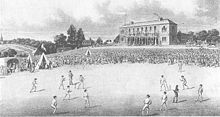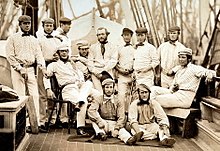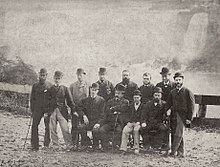
The Cricket World Cup is the quadrennial international championship of One Day International (ODI) cricket. The event is organised by the sport's governing body, the International Cricket Council (ICC), every four years, with preliminary qualification rounds leading up to a finals tournament. The tournament is one of the world's most viewed sporting events and considered the "flagship event of the international cricket calendar" by the ICC. It is widely considered the pinnacle championship of the sport of cricket.
Limited overs cricket, also known as white ball cricket, is a version of the sport of cricket in which a match is generally completed in one day. There are a number of formats, including List A cricket, Twenty20 cricket, and 100-ball cricket. The name reflects the rule that in the match each team bowls a set maximum number of overs, usually between 20 and 50, although shorter and longer forms of limited overs cricket have been played.

Test Cricket is a format of the sport of cricket, considered the game’s most prestigious and traditional form. Often referred to as the "ultimate test" of a cricketer's skill, endurance, and temperament, it is a format of international cricket where two teams in white clothing, each representing a country, compete over a match that can last up to five days. It consists of four innings, maximum of ninety overs are scheduled to be bowled per day making it the sport with the longest playing time. A team wins the match by outscoring the opposition in the batting or bowl out in bowling, otherwise the match ends in a draw.
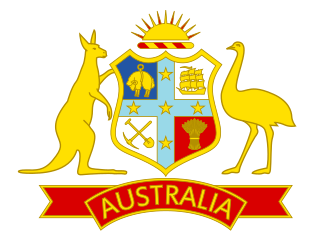
The Australia men's national cricket team represents Australia in men's international cricket. It is the joint oldest team in Test cricket history, playing in the first ever Test match in 1877; the team also plays One-Day International (ODI) and Twenty20 International (T20I) cricket, participating in both the first ODI, against England in the 1970–71 season and the first T20I, against New Zealand in the 2004–05 season, winning both games. The team draws its players from teams playing in the Australian domestic competitions – the Sheffield Shield, the Australian domestic limited-overs cricket tournament and the Big Bash League. Australia are the current ICC World Test Championship and ICC Cricket World Cup champions. They are regarded as the most successful cricket team in the history of cricket.

Jacques Henry Kallis OIS is a South African cricket coach and former professional cricketer. Widely regarded as one of the greatest cricketers of all time and as one of the greatest all-rounders ever to play the game, he was a right-handed batsman and right-arm fast-medium swing bowler. As of 2024, Kallis is the only cricketer in the history of the game to score more than 10,000 runs and take over 250 wickets in both ODI and Test match cricket. He has also taken 131 ODI catches. He scored 13,289 runs in his Test match career, took 292 wickets, and 200 catches. Kallis scored 45 Test match centuries and is the third highest test match run scorer in history. Kallis won 23 Man-of-the-Match awards, the most by any player in Test history.

The England men's cricket team represents England and Wales in international cricket. Since 1997, it has been governed by the England and Wales Cricket Board (ECB), having been previously governed by Marylebone Cricket Club since 1903. England, as a founding nation, is a Full Member of the International Cricket Council (ICC) with Test, One Day International (ODI) and Twenty20 International (T20I) status. Until the 1990s, Scottish and Irish players also played for England as those countries were not yet ICC members in their own right.
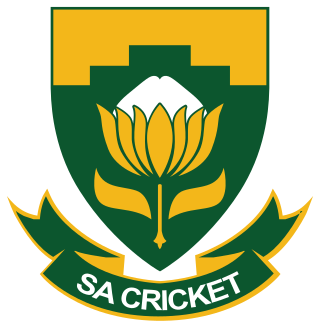
The South Africa men's national cricket team, also known as the Proteas, represents South Africa in men's international cricket and is administered by Cricket South Africa (CSA). South Africa is a full member of the International Cricket Council (ICC). Its nickname derives from South Africa's national flower, Protea cynaroides, commonly known as the "King Protea".

Twenty20 Cricket famously known as T20, is one of the three formats of cricket. Two others formats are Test cricket and One Day International (ODI). At the professional level, it was introduced by the England and Wales Cricket Board (ECB) in 2003 for the County cricket competition. In a T20 game, the two teams have a single innings each, which is restricted to a maximum of twenty overs. Together with first-class and List A cricket, Twenty20 is one of the three forms of cricket recognised by the International Cricket Council (ICC) as being played at the highest level, both internationally and domestically.
Cricket is a multi-faceted sport with different formats, depending on the standard of play, the desired level of formality, and the time available. One of the main differences is between matches limited by time in which the teams have two innings apiece, and those limited by number of overs in which they have a single innings each. The former, known as first-class cricket if played at the senior level, has a scheduled duration of three to five days ; the latter, known as limited overs cricket because each team bowls a limit of typically 50 overs, has a planned duration of one day only. A separate form of limited overs is Twenty20, originally designed so that the whole game could be played in a single evening, in which each team has an innings limited to twenty overs.

Women's Test cricket is the longest format of women's cricket and is the female equivalent to men's Test cricket. Matches comprise four-innings and are held over a maximum of four days between two of the leading cricketing nations. The rules governing the format differ little from those for the men's game, with differences generally being technicalities surrounding umpiring and field size.

Kevin Peter Pietersen is a former England international cricketer. He is regarded as one of the greatest English batsmen to have played the game. He is a right-handed batsman and occasional off spin bowler who played in all three formats for England between 2005 and 2014, which included a brief tenure as captain. He won the Player of the Series award for his performances in 2010 ICC World Twenty20 which helped England to win their maiden ICC trophy.

The Ireland men's cricket team represents all of Ireland in international cricket. The Irish Cricket Union, operating under the brand Cricket Ireland, is the sport's governing body in Ireland, and they organise the international team. The team have a number of home grounds, including Malahide in County Dublin, Stormont, Belfast, Bready in the north-west and Clontarf in Dublin city. A further ground is planned for the National Sports Campus in Abbotstown, Dublin for 2030. Due to the short season allowed by the Irish climate, and lack of large scale facilities, Ireland also occasionally play 'home matches' in venues in England and further abroad.

The South Africa women's national cricket team, nicknamed the Proteas, represents South Africa in international women's cricket. One of eight teams competing in the ICC Women's Championship, the team is organised by Cricket South Africa (CSA), a full member of the International Cricket Council (ICC).
The ICC Super Series 2005 was a cricket series held in Australia during October 2005, organised by the International Cricket Council (ICC). It was played between Australia and a World XI team of players selected from other countries. The series consisted of three One Day Internationals and one Test match. Australia won all four matches.

Women's cricket is the team sport of cricket when played by women. Its rules are almost identical to those in the game played by men, the main change being the use of a smaller ball. Women's cricket is beginning to be played at professional level in 11 of the 12 full members of the International Cricket Council (ICC), and is played worldwide, especially in Commonwealth nations.
The history of United States cricket begins in the 18th century. The first game was between the USA and Canada and held in 1844 in front of an audience of 5,000 spectators in New York. Among early Americans, cricket was as popular a bat and ball game as baseball. Though Americans never played cricket in great numbers, the game grew for some time. Around the time of the United States Civil War, the game began competing with baseball for participants, but then slowly declined in popularity. This was followed again by a brief golden age with the Philadelphian cricket team. This lasted until roughly the start of World War I; at this time, cricket again became less popular. In the latter part of the 20th century immigrants from cricket-playing nations in South Asia and the West Indies helped spark a resurgence in the game's popularity. This led to participation and success in several International Cricket Council events. In 2007, the United States of America Cricket Association was suspended by the ICC because of problems with its administration, but was again recognized beginning in 2008.

Cricket is the third most popular sport in South Africa. Traditionally played by English-speaking Whites, Indians, Coloureds and more recently, the Black community. The sport is now listed in the top two most popular among all race groups. Since the end of apartheid, a higher proportion of white players have come from Afrikaans-speaking backgrounds as well.
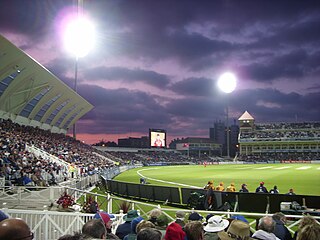
Day/night cricket, also known as floodlit cricket, is a cricket match that is played either totally or partially under floodlights in the evening. The first regular cricket to be played under floodlights occurred during World Series Cricket, unsanctioned by the International Cricket Council (ICC), attracting large crowds to see some of the world's best players compete in Australia and the West Indies. In 1979, when the ICC and World Series Cricket came to an understanding, the first floodlit One Day International was played, also in Australia. Floodlit cricket has since been played around the world, although England was slow to take it up due to their climate. Floodlit first-class cricket was first played in 1994, when the concept was tried during the Sheffield Shield. Day/night cricket is now commonplace in one-day cricket and Twenty20 cricket. For instance, all 27 matches in the 2014 ICC World Twenty20 were day/night matches, as were most matches in the 2011 Cricket World Cup.

Cricket is a bat-and-ball game played between two teams of eleven players on a field, at the centre of which is a 22-yard pitch with a wicket at each end, each comprising two bails balanced on three stumps. Two players from the batting team, the striker and nonstriker, stand in front of either wicket holding bats, while one player from the fielding team, the bowler, bowls the ball toward the striker's wicket from the opposite end of the pitch. The striker's goal is to hit the bowled ball with the bat and then switch places with the nonstriker, with the batting team scoring one run for each of these exchanges. Runs are also scored when the ball reaches the boundary of the field or when the ball is bowled illegally.

Joseph Edward Root, is an English international cricketer, who plays for the English cricket team and formerly captained the Test team. He also represents Yorkshire in English domestic cricket. Root is currently the leading run-scorer among all active batsmen and the sixth highest run-scorer of all time in Test cricket and is the second highest run scorer for England after Sir Alastair Cook. Root is considered to be one of the greatest batsmen of his era and one of the greatest batsmen England has ever produced. He was part of the England team that won the 2019 Cricket World Cup where he top scored for England. He is also England's leading run scorer in the ICC World Cup and the only English player to score over 1000 runs. As of July 2024, he has topped the ICC rankings for Test batsmen on nine occasions.







